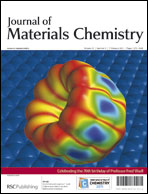Dual [proton]/[hole] mixed valence in a molecular metal: balancing chemical activity in the solid state by tapping into a molecular hole reservoir†
Abstract
We report on the synthesis, the layered triclinic P![[1 with combining macron]](https://www.rsc.org/images/entities/char_0031_0304.gif) crystal structure, band structure and Fermi surface analysis and preliminary transport and
crystal structure, band structure and Fermi surface analysis and preliminary transport and ![[double bond, length as m-dash]](https://www.rsc.org/images/entities/char_e001.gif) CH–CO2−](1−x)[−O2C–CH
CH–CO2−](1−x)[−O2C–CH![[double bond, length as m-dash]](https://www.rsc.org/images/entities/char_e001.gif) CH–CO2−]x, a metallic radical
CH–CO2−]x, a metallic radical
![Graphical abstract: Dual [proton]/[hole] mixed valence in a molecular metal: balancing chemical activity in the solid state by tapping into a molecular hole reservoir](/en/Image/Get?imageInfo.ImageType=GA&imageInfo.ImageIdentifier.ManuscriptID=C0JM02897E&imageInfo.ImageIdentifier.Year=2011)
- This article is part of the themed collection: Celebrating the 70th birthday of Professor Fred Wudl

 Please wait while we load your content...
Please wait while we load your content...